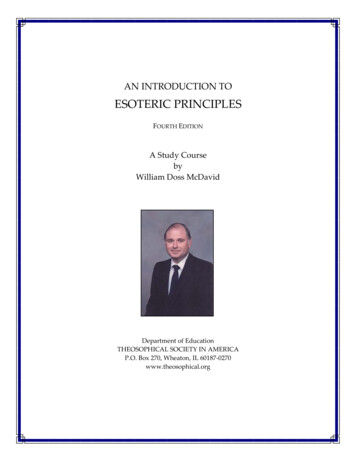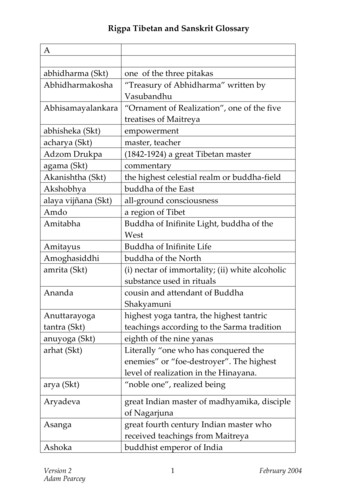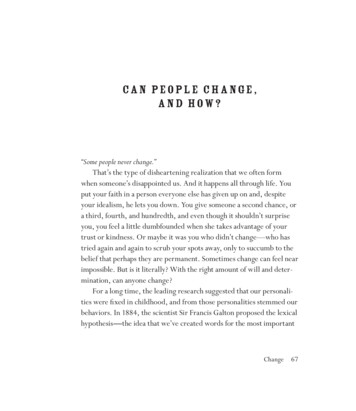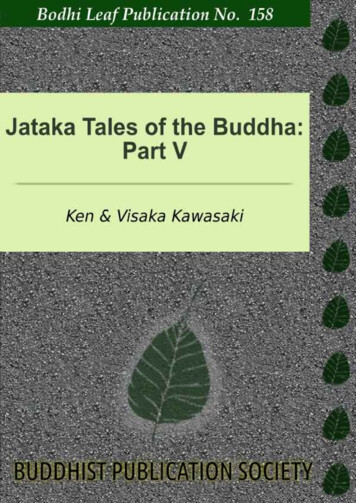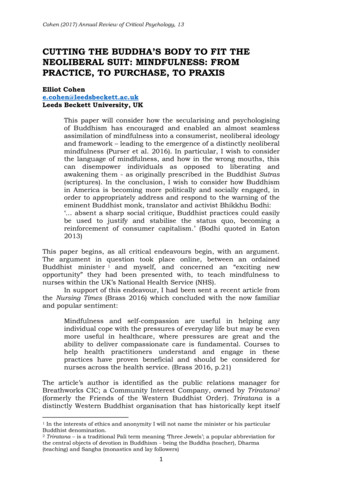
Transcription
Cohen (2017) Annual Review of Critical Psychology, 13CUTTING THE BUDDHA’S BODY TO FIT THENEOLIBERAL SUIT: MINDFULNESS: FROMPRACTICE, TO PURCHASE, TO PRAXISElliot Cohene.cohen@leedsbeckett.ac.ukLeeds Beckett University, UKThis paper will consider how the secularising and psychologisingof Buddhism has encouraged and enabled an almost seamlessassimilation of mindfulness into a consumerist, neoliberal ideologyand framework – leading to the emergence of a distinctly neoliberalmindfulness (Purser et al. 2016). In particular, I wish to considerthe language of mindfulness, and how in the wrong mouths, thiscan disempower individuals as opposed to liberating andawakening them - as originally prescribed in the Buddhist Sutras(scriptures). In the conclusion, I wish to consider how Buddhismin America is becoming more politically and socially engaged, inorder to appropriately address and respond to the warning of theeminent Buddhist monk, translator and activist Bhikkhu Bodhi:‘ absent a sharp social critique, Buddhist practices could easilybe used to justify and stabilise the status quo, becoming areinforcement of consumer capitalism.’ (Bodhi quoted in Eaton2013)This paper begins, as all critical endeavours begin, with an argument.The argument in question took place online, between an ordainedBuddhist minister 1 and myself, and concerned an “exciting newopportunity” they had been presented with, to teach mindfulness tonurses within the UK’s National Health Service (NHS).In support of this endeavour, I had been sent a recent article fromthe Nursing Times (Brass 2016) which concluded with the now familiarand popular sentiment:Mindfulness and self-compassion are useful in helping anyindividual cope with the pressures of everyday life but may be evenmore useful in healthcare, where pressures are great and theability to deliver compassionate care is fundamental. Courses tohelp health practitioners understand and engage in thesepractices have proven beneficial and should be considered fornurses across the health service. (Brass 2016, p.21)The article’s author is identified as the public relations manager forBreathworks CIC; a Community Interest Company, owned by Triratana2(formerly the Friends of the Western Buddhist Order). Triratana is adistinctly Western Buddhist organisation that has historically kept itselfIn the interests of ethics and anonymity I will not name the minister or his particularBuddhist denomination.2 Triratana – is a traditional Pali term meaning ‘Three Jewels’; a popular abbreviation forthe central objects of devotion in Buddhism - being the Buddha (teacher), Dharma(teaching) and Sangha (monastics and lay followers)11
Cohen (2017) Annual Review of Critical Psychology, 13quite separate from more traditional and indigenous schools ofBuddhism, and is dedicated to translating the Buddhist teachings for aWestern audience. Breathworks CIC offers secular mindfulness training(and teacher training) programmes for both individuals andorganisations3.This increasing enthusiasm for Mindfulness-Based Interventions(MBIs) had been previously affirmed and further articulated in an AllParty Parliamentary Report from October 2015 titled ‘Mindful Nation UK’;which has outlined and advised the application of mindfulness to suchdiverse areas as Health, Education, the Work Place and the CriminalJustice System – I will consider this document, its language and contextmore fully, later in this paper.The Buddhist minister in question, expressed excitement andoptimism that this increasing interest in mindfulness reflected a ‘seachange’ in individual, societal and governmental attitudes towards therole meditation may soon play in promoting wellbeing; but I did not sharehis optimism.In 2010 I had written the article ‘The Psychologisation ofBuddhism: From the Bodhi tree, to the analyst's couch, then into theMRI scanner’ which had outlined some of the ways in which Buddhismhad been increasingly secularised and medicalised – but I now wonder ifthis article went far enough, and whether I sufficiently identified andaddressed the socio-economic and political context within which thesetransformations were occurring (and to what end?); this is what I intendto explore in this article. It took the Buddhist minister’s new ‘opportunity’to serve as the catalyst for this more politically-aware critique to takeshape, and I had consequently replied in a short private message:Having previously worked for an NHS trust, I have genuineconcerns about these new trends of corporate-based mindfulnesstraining. I do not doubt that nurses are faced with increasingpressures and are suffering terribly from stress. But we mustrecognise that this is largely due to their working conditions.Nurses are generally overworked, overmanaged, underpaid,understaffed and underappreciated!In short, this appeared to perfectly illustrate the neoliberal strategy ofprivatising stress and anguish (Fisher 2011), deflecting responsibilityaway from NHS managers and politicians, and instead requiring theworkers – in this instance the nurses - to simply ‘better manage’ and‘adapt’ to their stressful work environment.Mindfulness – Defined and Re-DefinedThe term Sati - ‘mindfulness’ is just one term4 found within the Buddhistlexicon for practices which are typically translated as ‘meditation’. Indeed,the decision to term the practice ‘mindfulness’, as opposed to ‘meditation’appears to be part of a general movement to de-spiritualise what wastraditionally a contemplative / accessed 31.03.17Others include Samadhi – concentration/absorption, Bhavana – cultivation, Samatha –calm abiding and Vipassana – insight meditation.342
Cohen (2017) Annual Review of Critical Psychology, 13Perhaps the most popular, familiar, and secular definition ofmindfulness comes from its leading proponent Jon Kabat-Zinn, who hasdefined it as:The awareness that emerges through paying attention on purpose,in the present moment, and nonjudgmentally to the unfolding ofexperience moment by moment. (Kabat-Zinn 2003, p.145)This awareness is further enhanced through seven attitudinalfoundations; ‘non-judging, patience, beginner’s mind, trust, non-striving,acceptance and letting go’ (Kabat-Zinn 2004, pp.33-40).Within its original Buddhist context, mindfulness is encounteredas part of the Noble Eightfold Path 5 , and is contained within a welldefined and purposefully structured training system; which includes aparticular emphasis on ethical training (sila).The purpose of this training was, and remains the realisation ofNirvana - Awakening 6 , and the purpose of meditation was toexperientially investigate, recognise and realise the Buddhist teachings.The problems emerge when one intentionally begins to remove these‘attitudinal foundations’ from their Buddhist context. As one Englishacademic and Tibetan Buddhist Master, Lama Jampa Thaye, has notedin his article ‘Living by Meditation Alone’:Secular mindfulness has found a place in society, but occupyinga somewhat different cultural and spiritual space, a newBuddhism has emerged alongside it. Its adherents claim thatthe fruits of the Buddhist tradition can be acquired throughsitting meditation alone. Contemporary practitioners, in otherwords, need not bother with study, ethical precepts, ritualpractice (other than meditation), or merit making. (Thaye 2015)Indeed this ‘cultural and spiritual space’ had already been ably exposedand outlined by Carrette (2007) and Carrette and King (2005) asconstituting a neoliberal hegemony; in which spirituality itself has beengradually and successfully commodified; whilst Asian Wisdom traditions(especially Buddhism) have been increasingly privatised (Carrette andKing 2005, pp.87-122).Once this new neoliberal context is recognised, alongside itsmarket and management-centeredness, emphasis on competition,extreme individualism (particularly in regards to individual responsibility)and the continued promotion and expansion of a consumerist cultureand value system (Monbiot 2017), then these attitudinal foundations andthe language of ‘non-judging, non-striving’ and ‘acceptance’ becomeproblematic; as one appears to be potentially removing or weakeningpeople’s capacity to resist or object 7 – which would appear to be theobjective of ‘neoliberal mindfulness’.Right view, Right Intentions, Right Speech, Right Action, Right Livelihood, Right Effort,Right Mindfulness, Right Concentration (Bodhi 1999)6 This term is understood and translated in various ways, but is most simply expressedas the extinguishing of the three poisons of craving, hatred and ignorance.7 It is useful at this point to consider the minority opinion of one Buddhist Professor ofNagpur University, who was part of Ambedkarite Buddhist movement, who warned that53
Cohen (2017) Annual Review of Critical Psychology, 13The Buddha in a Business Suit8In the business world one can observe the popularity of mindfulness as away to ensure one remains as competitive and as ‘awake’ to potentialopportunities as possible. The Harvard Business Review has nowpublished numerous online articles over the last several years whichillustrate and celebrate the new role mindfulness is playing in thecorporate world.One typical example included the headline - ‘Mindfulness canliterally change your brain’ (Congleton et al. 2015) and investigated therole of increased activity in the ‘anterior cingulate cortex’, which isenhanced through mindfulness, plays in ‘self-regulation’ and also‘optimal decision making’. They also consider the role of hippocampusand limbic system, which they report can be damaged and depleted bystress; whilst noting that in meditators there appears to be ‘increasedamounts of gray matter’. They conclude ‘Mindfulness should no longer beconsidered a “nice-to-have” for executives. It’s a “must-have”’ (Ibid.)This designating mindfulness as a “must-have”, reconstrues the practiceinto a purchase; instead of a meditative discipline to cultivate,mindfulness becomes simply yet another commodity or something toacquire. But the article also demonstrates how the language and practiceof mindfulness may be medicalised and essentially reduced tocommentary on brain structure and chemistry.The neuroscientific language, complete with brain imaging scansfrom MRIs, provides the scientific seal of authenticity – although it ishighly unlikely that a largely non-specialist audience of businessexecutives would be in a position to critically evaluate the informationprovided. In summary, the article appears to possess many of thehallmarks scientism and the ‘cult of neuroscience’ (Lears 2015, p.214),but its language also has the effect of de-contextualising and redirectingour discussions concerning stress, particularly in terms of socioeconomic or working conditions, to the measuring of one’s cortisol levels.In this same manner, one might argue that if one is not happy it isprimarily due to one’s inability to metabolise serotonin efficiently.The ‘Blanding’ of MindfulnessOne notable article that generated a lot of debate was Ron Purser andDavid Loy’s (2013) ‘Beyond McMindfulness’, published in the HuffingtonPost. Purser and Loy are both authorised teachers in the Zen tradition,and objected to what they saw as the unacknowledged ‘shadow’ of the‘mindfulness revolution’. The label/accusation ‘McMindfulness’ isparticularly effective as it effortlessly evokes associations of fast food, alazy, quick-fix culture, and perhaps also suggests a lack of genuinethe values of ‘equanimity, peace and tolerance’ (Queen 2003 pp.2-3) cultivated inmeditation may actually serve to weaken the community’s activism and resistanceagainst the Indian caste system.8 ‘Buddha in a business suit: The art of heartful management’ is the full title of a book bymeditation teacher and musician Johannes Linstead (2010).4
Cohen (2017) Annual Review of Critical Psychology, 13spiritual nourishment. In addition to considering the commodification ofmindfulness they also refer directly to Carrette and King (2005) whenconsidering the socio-political implications:The result is an atomised and highly privatized version ofmindfulness practice, which is easily co-opted and confined towhat Jeremy Carrette and Richard King, in their book SellingSpirituality: The Silent Takeover of Religion, describe as an“accommodationist” orientation. Mindfulness training has wideappeal because it has become a trendy method for subduingemployee unrest, promoting a tacit acceptance of the status quo,and as an instrumental tool for keeping attention focused oninstitutional goals. (Purser and Loy 2013)These arguments are reminiscent of some of my earlier critiques (Cohen2010) of Buddhist modernism and its transformation of Buddhism intosecular forms of psychotherapy committed to ‘adjustment’ as opposed toawakening. It is also significant to note that in Carrette and King’soriginal discussion of accommodationism, they were directly referring thework of noted Integral theorist (former pioneer of TranspersonalPsychology) Ken Wilber, who had also been quite adamant aboutrecognising and preserving the spiritual roots of meditation:Meditation, it is said, is a way to evoke the relaxation response atechnique for calming the central nervous system; a way to relievestress, bolster self-esteem, reduce anxiety, and alleviatedepression But I would like to emphasise that meditation itselfhas always been a spiritual practice. (Wilber 1993, p.76)Similar sentiments have been echoed in more recent academic articles(Reveley 2016, Hyland 2016, Hyland 2015).Hyland’s (2015) paper ‘McMindfulness in the workplace: vocationallearning and the commodification of the present moment’, critiques the‘mutation’ of mindfulness from its original focus on liberation to thedecontextualisation of mindfulness from its Buddhist roots and practice –in particular its exclusion of the ethical commitments and trainings.Hyland’s (2016) following paper ‘The erosion of right livelihood: countereducational aspects of the commodification of mindfulness practice’elaborates upon the ‘McDonaldizing’ of mindfulness, and the need formore emphasis on the Buddhist ethical foundations; in this instance,particular attention is given to ‘Right Livelihood’ – the Fifth Noble Truthof the Buddha’s teaching, which traditionally precedes mindfulness(which is the Seventh).He proceeds to outline four elements that represent the processthrough which mindfulness has become commodified – these include anemphasis on (or perhaps obsession with) enhancing efficiency,calculability, predictability and control through non-human technology.It is significant to note that these first three elements are a frequentfeature of many forms of Cognitive Therapies, of which MindfulnessBased Approaches are considered a new ‘Third Wave’ (Wells and Fisher2016). I have previously considered the extent to which forms of5
Cohen (2017) Annual Review of Critical Psychology, 13Cognitive-Behavioural Therapy (CBT) uses the language and semiotics ofinformation processing (Cohen 2010); particularly in the way processes ofthoughts, feelings and courses of treatment are typically represented - inthe form of flow charts and algorithms.At first this more mechanistic way of reducing human experienceto human functioning may appear at odds with more ‘holistic’mindfulness-based approaches, and yet increasingly one may notice howthe language of stress and stress-reduction, for which mindfulness ispresented as the ‘universal panacea’ (Purser and Loy 2013), has becomemechanised to the point where it is now quite common to hear referencebeing made to causes of stress being due to ‘information overload’, whichmay in turn result in ‘burnout’ (Adams 2016). Attending more closely tothe language of stress may allow us to reformulate the problem of ‘controlthrough non-human technology’ as instead being more an issue of‘overidentification’ with non-human technology. In fact, thisoveridentification may well be being encouraged by advocates ofneoliberalism to further entrench their ideological hegemony:In neoliberal theory, the market is seen metaphorically as amachine for the coordination of the interests and actions of freeindividuals in a rational benevolent fashion. In the digitaldiscourse, and with the introduction of network technology, thismachine is no longer merely a metaphor; it is a reality, assumed toreaffirm and fortify neoliberal claims. (Fisher 2010, p.76)One should also reflect on the increasing use of digital media tocommunicate and teach the principles and practice of mindfulness, andthat in terms of locations of learning, we have moved from Buddhisttemples, to clinical settings into increasingly online/virtual formats.Currently, one of the most popular ways people are being introduced tomindfulness is through the downloading of Apps such as ‘Headspace’,‘Smiling Mind’ and ‘Buddhify’ etc. When one considers the moreimpersonal and privatised nature of these mediums, alongside thepreviously considered neoliberal objectives, then a scenario begins toemerge that may appear reminiscent of Adam Curtis’ (2002) documentary‘Century of the Self’ - where he considers the birth of consumer cultureand the reimagining of humanity as “constantly moving happinessmachines”9.This reimagining may begin with forms of re-educating, and moreextreme reactions to mindfulness have included David Forbe’s (2015)Salon article, which bore the headline ‘They want kids to be robots’ andcontained the subtitle ‘“Reformers” talk about mindfulness as if it’s ananswer, not just another way to sneak corporate culture in schools’.Reveley (2016) provides further commentary concerning the increasingpopularity of school-based mindfulness training in his paper, titled‘Neoliberal meditations: How mindfulness training medicalises educationand responsibilises young people’. He explores the concept of ‘selftechnology’ and provides a critical account of teaching mindfulness inschools as being a subtle method to instil neoliberal values into children9This is identified as a quote from President Herbert Hoover6
Cohen (2017) Annual Review of Critical Psychology, 13under the seemingly benign headings and activities of therapy and wellbeing:Learning to become mindful is one way members of the youngergeneration become charged with a moral responsibility to augmenttheir own emotional well-being. The capacity for personalprevention and self-surveillance that school-based mindfulnesstraining inculcates in the young in turn, is central to the selfmanaging figure that neoliberalism prizes. (Reveley 2016, p. 497)In the current political and economic climate, it appears we have movedaway from discourses of happiness to a more attainable and generalobjective of ‘Well-Being’ – and perhaps were President Hoover alive today,in this digital age, he may celebrate the emergence of neoliberalmindfulness as initiating the construction of “generally passive, serenitycyborgs.”It is this passivity and tacitly amoral approach to neoliberalmindfulness that may be responsible for one of the more shockingabuses of the practice – its weaponisation. In Hyland’s (2016) discussionof non-human technology, he also recognises the increasing use ofmindfulness by the military, specifically the Mindfulness-based MindFitness Training (MMFT). Although his discussion is rather brief, it didremind me of Brian Daizen Victoria’s (2006) work ‘Zen at War’, whichprovided a sobering account of how Zen Buddhism was distorted into anationalist, militarist ideology during the Second World War; an ideologythat would effectively train Japanese soldiers to both live and kill in thepresent moment. The MMFT would appear to present similar risks as canbe seen in Ronald Purser’s (2014) article titled ‘The Militarisation ofMindfulness’, in which Purser quotes Dr Elizabeth Stanley, founder ofthe MMFT programme:The military already incorporates mindfulness training, although itdoes not call it this – into perhaps the most fundamental soldierskill, firing a weapon. Soldiers learning how to fire the M-16 rifleare taught to pay attention to their breath and synchronise thebreathing process to trigger the finger’s movement, “squeezing” offthe round when exhaling. (Stanley quoted in Purser 2014)This is, needless to say, totally at odds with Buddhist ethics, whose veryfirst precept is:Pānātipātā veramanī sikkhāpadam samādiyāmiI undertake the rule of training to refrain from killing any livingthings. (Saddhātissa 1990, pp.5-6)This last example, perhaps more so that the previous examples related topsychologisation and commodification, demonstrates the inherent dangerof divorcing mindfulness from its traditional, spiritual and ethicalframework.7
Cohen (2017) Annual Review of Critical Psychology, 13Remembering MindfulnessWhen considering the many transformations and translations ofmindfulness it is important to refer back to its original meaning, which isdiscussed by Buddhist monk and translator Thanissaro Bhikkhu:The British scholar 10 who coined the term “mindfulness” totranslate the Pali word sati was probably influenced by theAnglican prayer to be ever mindful of the needs of others—in otherwords, to always keep their needs in mind. But even though theword “mindful” was probably drawn from a Christian context, theBuddha himself defined sati as the ability to remember,illustrating its function in meditation practice with the foursatipatthanas, or establishings of mindfulness. (ThanissaroBhikkhu 2008)In regard to its etymological roots sata – remembering, it is alsoworthwhile remembering its origins in the Buddhist spiritual tradition, asthis may well provide a means of resistance to neoliberal distortions ofthe practice, as will be discussed in the final part of this paper.It is arguably the secularising and psychologising of Buddhismthat has placed the practice into such an ambiguous position; one thatleaves it wide open to commercial exploitation, assimilation anddistortion. We can see examples of this ambiguity reflected both in thewritings and role Jon Kabat-Zinn plays as one of the leading proponentsof secular mindfulness.Despite Kabat-Zinn’s significant training in traditional Buddhistschools11 he appears openly and defiantly secular in his approach. In arecent interview in The Psychologist, titled ‘This is not McMindfulness’, heis quite clear in asserting, ‘First of all, I really try to stay as far away fromthe word spiritual as possible’ (Kabat-Zinn quoted in Shonin 2016, p.124).He continues to explain how the term may be misunderstood andpolarising, at one point reflecting: if I call mindfulness a spiritual practice, then of course there willbe people that think that’s wonderful and there will be an equalnumber of people, or ten times as many people that think wellthat’s kind of religion, voodoo, really it’s nonsense, and they won’thave anything to do with it. (Ibid. p.124)In a previous panel interview organised by the Nour Foundation he wasmore explicit in his attitude towards the term ‘spirituality’ – ‘I tend tostay away from the word spiritual as if it had some sort of toxicoutpouring.’ (Kabat-Zinn 2013)And yet, when defending his secular forms of mindfulness trainingfrom accusations of ‘McMindfulness’ he returns, or resorts to appealsreemphasising the spiritual roots, antiquity and authenticity ofBuddhism:Thomas Williams Rhys Davids (1843-1922), founder of the Pali Text Society.Primarily in the Zen traditions with Vietnamese Master Thich Nhat Hanh, and KoreanMaster Suengsahn.10118
Cohen (2017) Annual Review of Critical Psychology, 13This is not McMindfulness by any stretch of the imagination. Whatit is – now I have to use some Buddhist terminology – it is themovement of the Dharma [the Buddhist teachings] into themainstream of society. Buddhism really is about the Dharma – it’sabout the teachings of the Buddha. (Kabat-Zinn quoted in Shonin2016, p.125)On one level, there appears to be the recognition that it is the source ofthese teachings, the Buddha and by extension Buddhism, which givesthis practice authenticity, legitimacy and lineage, and yet,simultaneously he prefers to place emphasis on the arguably lesserknown Buddhist term ‘Dharma’; perhaps to ‘play down’ the spiritualelements by placing more emphasis on the teachings as opposed to theteacher. But it is difficult to conceive of any traditional translation ofDharma that doesn’t recognise its role as being primarily a spiritualteaching and training, primarily concerned with spiritual transformationand transcendence12.Yet there is another ambiguity of role that needs to be recognisedon the part of the teacher of mindfulness – somewhere between mentalhealth professional and Lama/Guru. This can be illustrated in KabatZinn’s address to the Google company in 2007. He was invited andintroduced by Google’s ‘Jolly Good Fellow’ 13 enthusiast and devoteeChade-Meng Tan. Tan (2016) would go on to author ‘Joy on demand: theart of discovering happiness within’ – a title which once again ratheraptly illustrates the consumer-driven approach to both happiness andwellbeing. Tan reflects:When I was young I read his first book14. This book deepened myinterest and understanding of meditation, and from thismeditation that I found inner peace and happiness, and I’ve beenjolly ever since. (Kabat-Zinn and Tan 2007)Following his introduction Tan greets Kabat-Zinn with a traditionalNamaste gesture of placing both his palms together in the same mannerin which one might honour an Indian Guru or Tibetan Lama (one’sspiritual guide). It is not clear from the video (due to the angle of thecamera) whether or not Kabat-Zinn returns the gesture, but it does raiseinteresting questions as to the role and status of teachers of mindfulness.Perry London had previously warned of the potential for thePsychologist/Psychotherapist to become akin to a ‘secular priest’ (London2014, p.xii), and considering the spiritual, Buddhist roots of mindfulnessthere is every chance that this risk will increase exponentially, and thatteachers of mindfulness assume the role, either consciously orunconsciously, of a secular Lama - but in this case of Kabat-Zinn, aspiritual teacher who consistently and intentionally excludes spirituality.In Kabat-Zinn’s address to Google 15 one encounters more of thenow familiar, mechanistic language of stress and mindfulness. At oneSpecifically pertaining to the Four Noble Truths concerning the nature of suffering, theNoble Eightfold Path and the attainment of Awakening/Nirvana.13 His former official job title at Google14 Kabat-Zinn’s ‘Full Catastrophe Living’ first published in 199115 Which to this date has over 3 million views on YouTube.129
Cohen (2017) Annual Review of Critical Psychology, 13point the purpose of mindfulness is described as ‘ tuning yourinstrument before you take it out on the road’ (Kabat-Zinn and Tan 2007)and this is further reinforced by the stated disadvantages of not beingmindful, which include: impeding creativity, imagination, real thoughtfulness, realbreakthrough type leadership sensibilities, because we’re not firingon all cylinders. (Ibid.)There is also a degree of psychopathologisation evidenced in Kabat-Zinn’scharacterisation of modern society’s lack of mindful awareness, but againhighlighting the ambiguity of mindfulness, this psychiatric terminology ispresented as a spiritual insight:So from the point of view of the meditative traditions, the entiresociety is suffering from attention deficit hyperactivity disorder –certifiable diagnosis. (Ibid.)This is a curious statement, or discursive strategy, as it implicitlysuggests that the Buddhist and Hindu traditions are (or were) ‘in thebusiness’ of diagnosing and treating psychiatric conditions as opposed tobeing devoted to spiritual liberation – Nirvana or Moksha; thus thespiritual traditions are presented as willing and active partners in whatcritical psychologists would recognise and term as the ‘psy-complex’ (Foxand Prilleltensky 2001, p.287).Mindful Nation UKOctober 2015 marked the publication of an All-Party ParliamentaryReport which included the following stated aims:review the scientific evidence and current best practice inmindfulness trainingdevelop policy recommendations for government, based on thesefindingsprovide a forum for discussion in Parliament for the role ofmindfulness and its implementation in public policy (MindfulnessAll-Party Parliamentary Group 2015)The particular areas identified where mindfulness may make a significantimpact included Health, Education, the Work Place and the CriminalJustice System. Jon Kabat-Zinn contributed to the discussions which ledto the publication of the report and also wrote its foreword.The practice of mindfulness is discussed primarily in relation to thetraining of one’s attention, again emphasising self-management:It is typically cultivated by a range of simple meditation practices,which aim to bring a greater awareness of thinking, feeling andbehaviour patterns, and to develop the capacity to manage thesewith greater skill and compassion. (Ibid. p.14)10
Cohen (2017) Annual Review of Critical Psychology, 13The spiritual origins of Mindfulness are also discussed very briefly anddismissively:Methods for training mindfulness have long been central to thecontemplative traditions of Asia, especially Buddhism. Using thesemethods, but freeing them from any religious or dogmatic content,Jon Kabat-Zinn began teaching his Mindfulness-Based StressReduction course (MBSR) to patients at the University ofMassachusetts Medical Center in the late 1970s. (Ibid. p.14)It is important to note that there is no attempt to describe or explainwhat constitutes ‘religious or dogmatic’ content, or to justify why thesefeatures were deemed, or perceived as superfluous and in need ofextraction. The reference to ‘skill and compassion’ has a particularmeaning within a Buddhist context, both of which arguably pertain toone’s ethical
way to ensure one remains as competitive and as ‘awake’ to potential . In summary, the article appears to possess many of the hallmarks scientism and the ‘cult of neuroscience’ (Lears 2015, p.214), . Purser and Loy are both a


